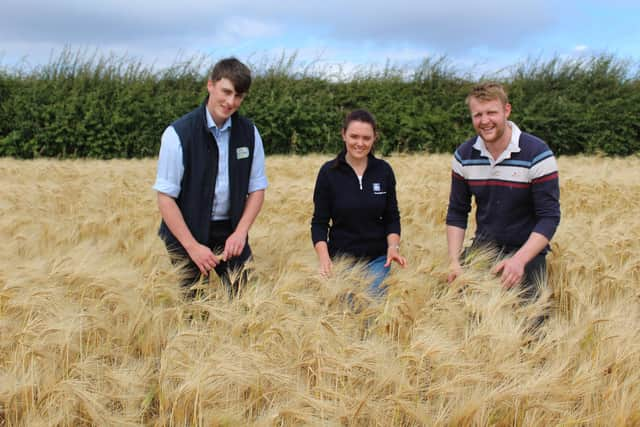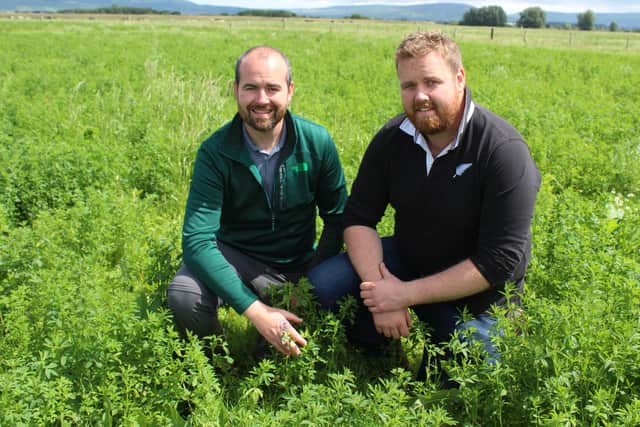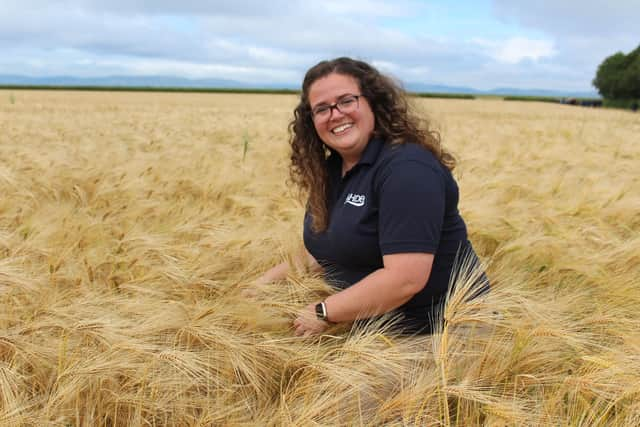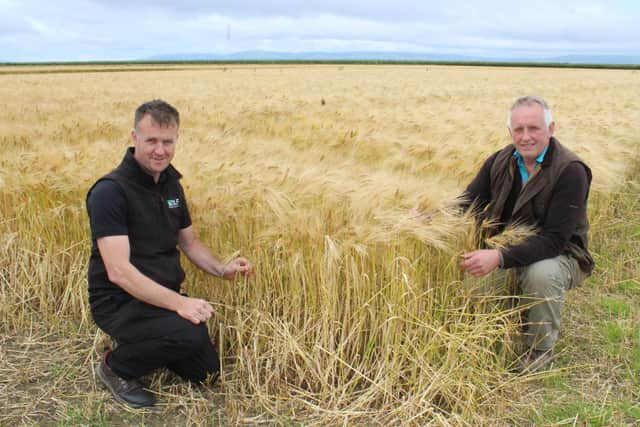NI has a new AHDB cereals andoilseeds’ monitor farm
and live on Freeview channel 276
The Craig family own Carsehall Farm, located on the outskirts of Limavady. Their business comprises an extensive winter and seed barley operation, which is managed in tandem with a herd of pedigree Holstein dairy cows.
Alistair recently hosted an inaugural open day, which was attended by 40 plus arable farmers from across Northern Ireland.
Advertisement
Advertisement
Also in attendance was Michelle Nuttall, AHDB’s Knowledge Exchange Manager – Cereals & Oilseeds.


She explained:“There are 23 monitor farms, located across the UK. Each holds this entitlement for three years.
“During this period, each farm will host a summer walk and two winter meetings.
“The purpose of a monitor farm is to highlight the opportunities and challenges that exist to other to other arable producers within its catchment area.”
Advertisement
Advertisement
Nuttall added:“The business and management conditions prevailing In the East of England will be completely different to those that are impacting in Northern Ireland.


“So it’s important that the monitor farm programme reflects all of this in the most effective way possible.”
The AHDB representative confirmed that the support arrangements prevailing in Northern Ireland, relative the rest of the UK, may well start to move in different directions over the coming years, adding:“For the most part farm size in Northern Ireland is smaller, relative to other parts of the UK.
“So the retention of a support mechanism based around the basic payment model suits this family-focussed form of agricultural infrastructure.”
Advertisement
Advertisement
A total of six new AHDB cereals and oilseeds monitor farms have been appointed across England, Wales and Northern Ireland over recent months.


AHDB’s Graham Bannister, who co-ordinates the monitor farm programme for arable farmers, explained: “What makes this batch of monitor farmers unique is that their term will cover a particularly volatile time in farming. Over the next three years it is likely that the farming industry will experience large changes in policy and trade. Monitor Farms are a vital part of the UK farming’s toolbox, helping the industry not just to survive, but thrive.
“We know from our annual monitor farm survey that those who attend the meetings find the programme helps them to improve their business decision-making. By being involved at this crucial time farmers can gain independent expert advice as well as sharing knowledge and experiences with their local peers.”
The new monitor farm hosts were selected by AHDB staff and board members and will be supported by a steering group of other local farmers and agronomists. In the case of Alistair, the steering group will include representatives from the College of Agriculture, Food and Rural Enterprise (CAFRE) and the Agri-Food and Biosciences Institute (AFBI).
Advertisement
Advertisement
The farmers were chosen for their ability to hit the industry’s challenges head-on and to challenge their own thinking.


Bannister commented:“Being open-minded means they are receptive to trying out new technology and ideas on their farms.
“The monitor farm ethos of farmer-led: farmer-driven is still key to its success. Farmers who get involved in their local Monitor Farm programme can help drive and direct their industry into a successful future.”
A steering group sets the agenda for each of the monitor farm meetings, making sure that the topics are the most relevant for the local farming community.
Harvest 2022
Advertisement
Advertisement
Weather permitting, the first of this year’s winter barley crops to be harvested in Northern Ireland will be cut in parts of Co Down next week.
“Yields look very promising,” confirmed Fane Valley agronomist Christian Melly.
“For the most part, weather conditions have been pretty cool and damp during the 2022 growing season.
“As a consequence, ears have had an opportunity to fill out well. This is in total contrast to last year, when the very dry conditions hampered final yields.”
Advertisement
Advertisement
Melly made these comments while attending the open day hosted earlier this week by Alistair Craig, Northern Ireland’s new AHDB cereals and oilseeds monitor farmer. He expects winter barley yields to come in at around 3.5t/ac with many exceed 4.0t
In total contrast, it could be the last week of July, or even the first week of August, before the combines start rolling in the North West Derry area.
The Craig family grow 80ha of feed grade winter barley and an additional 30ha of barley, grown to seed certification standards, at its Carsehall farm – near Limavady.
A herd of 240 pedigree Holstein cows complements the tillage operation.
Advertisement
Advertisement
A proportion of the winter barley acreage has already been harvested as wholecrop.
“We ensiled 200t of forage from the 19ac of crop that were cut,” Alistair explained.
“This bodes well for the barley that we harvest grain in a fortnight or so.”
Approximately 40 farmers from the North West Derry area attended the open day. The threat of Barley Yellow Dwarf Virus (BYDY) was discussed at length.
Advertisement
Advertisement
According to the host farmer, aphid were not that big of an issue on the farm.
He added:“We grow the 6-row variety Amistar, which is tolerant of BYDV. We aim to sow our winter barley crops as early in the season as possible. Last year, we had all the ground planted out by 15 September.
“After emergence we walked all the crops. Aphids were evident in some of the field. The decision was taken to go with an insecticide at those locations.”
Christian Melly confirmed that BYDV is less of a threat in coastal areas.
Advertisement
Advertisement
“However, it represents a real yield threat in other parts of the country.”
The Fane Valley agronomist recommends the use of the T-Sum 170 rule when it comes to determining the likelihood of an aphid attack.
The T-sum is calculated by subtracting 3oC from the average temperature each day and adding the result to the running total.
When the T-sum reaches 170, it’s an indicator that aphids could be starting to appear in barley crops.
Advertisement
Advertisement
“At that stage, growers can decide whether or not to apply an aphicide,” Melly concluded.
Using slurry as a fertiliser source for cereals
Alistair Craig uses 5,000g/ha of cattle slurry as a key driver of his crop fertiliser policy.
As he pointed out to visitors taking part in a recent open day at the family’s Limavady farm, making use of organic manures can make a real and positive difference when growing high yielding crops of winter barley.
He explained:“Our 240 dairy cows and followers provide us with plenty of farmyard manure and slurry.
Advertisement
Advertisement
“Approximately 2,000g/ha of slurry is applied in the autumn with a follow-up 3,000g in April.
“I discount the nitrogen in the slurry applied at the back end. However, the slurry spread in the spring accounts for 70 units of the 160 units/ac of total nitrogen applied to the barley.
“The combined slurry applications deliver all the potash and phosphate required by the cereal crops.”
Alistair spreads the slurry using an umbilical system with a dribble bar attachment.
Advertisement
Advertisement
He added:“We have never had a problem with slurry crusting of the growing crop. In the first instance, it normally has a dry matter content of 5% or less.
“And, in addition, we tend to get a fair amount of rain in this part of the world. As a result, the applied slurry is washed down to soil level very quickly.”
Alistair believes that slurry brings other fertiliser-related benefits when applied to a growing cereal crop.
He said:“Slurry contains not insignificant quantities of specific trace elements which will act to boost crop growth.”
Advertisement
Advertisement
The past couple of years have seen Alistair apply the remaining 90 units of nitrogen to his barley crops in the form of liquid fertiliser.
“To date, my experiences of taking this approach have been very positive. I have reduced by total nitrogen usage rate by between 15 and 20%”
Alistair has opted for a liquid fertiliser specification that contains 20% nitrogen and 5% sulphur.
Making this happen encouraged him to buy a new sprayer with a 500L tank and a 36 boom width.
Advertisement
Advertisement
“The one machine is now used for all the spraying and nitrogen application work, so it’s getting plenty of work,” he stressed.
“Our tram lines are set at 12m spacings.
“All the working parts on the sprayer are made from stainless steel. And this is very important, as liquid fertilise is very corrosive in nature.
“It is also important that the sprayer is thoroughly washed out every time it is used to apply nitrogen.”
Alistair concluded:“It is possible to have potash included in a liquid fertiliser specification. But it is a very expensive option.”
The true value of straw
Advertisement
Advertisement
College of Agriculture, Food and Rural Enterprise (CAFRE) tillage specialists have highlighted the options available to cereal growers, where the effective management of straw is concerned.
Yes it can be baled. But straw can also be chopped and, subsequently, incorporated back into the soil.
Strong demand for straw from livestock farmers for bedding and dietary fibre in recent years has resulted in the majority of arable farms in Northern Ireland baling rather than chopping straw.
Straw sales provide additional income and can aid cash flow, post harvest.
Advertisement
Advertisement
However, nutrients will be lost from the field with the removal of straw and there is a risk of compaction due to increased trafficking within the field during baling and loading. Weather conditions particularly if harvest is delayed can also make saving straw difficult.
A CAFRE spokesperson added: “Straw contains significant amounts of potash, and some phosphate and magnesium. Chopping and incorporating straw will ensure these nutrients are returned to the soil, thus improving soil health by adding organic matter and increasing carbon content of soils.
“Chopping also allows swift access for field operations such as establishing cover crops or early sown winter crops, although raking may be required to effectively spread chaff following combining. Short-term nutrient lock-up and the risk of carry-over of pest/disease can be issues with crop residues.
“There is an increase fuel cost associated with chopping straw and the ability to incorporate straw may be limited by the availability of combines equipped with straw chopping and effective spreading equipment on some farms.”
Advertisement
Advertisement
The spokesperson continued:”The decision to chop straw will be dependent on the value of straw at harvest time, the ability to chop straw on individual farms and the perceived value of improving soil health.
“Where straw is removed and return to the land as organic manure nutrients are recycled, benefiting bother arable and livestock enterprises.”
There is no straw incorporation measure on-offer to tillage farmers in Northern Ireland at the present time.
However, the issue was discussed at the AHDB farm walk hosted by Northern Ireland’s new AHDB cereals and oilseeds monitor farmer Alistair Craig.
Advertisement
Advertisement
National Trust farming advisor and former ADAS agronomist Kevin Duncan suggested that more should be done to identify ways of speeding up the decomposition of freshly incorporated straw within the soil.
To this end, he highlighted the work that had been carried out in England, assessing the impact of adding microbial supplements to newly planted cereal crops in the autumn time.
“This work be carried at the same time as fertiliser is first applied to newly established crops,” said Duncan.
“All of the growers taking part in the farm walk agreed that adding organic matter to arable crops delivers the key benefit of feeding the soils’ biology.”